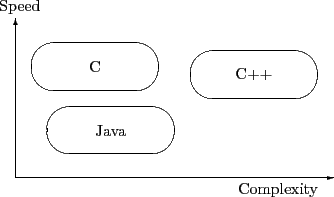1.2. Relationship of C to other programming Languages¶

1.2.1. Java and Python¶
Java and Python are both good language for learning object oriented programming.
They have rich libraries for implementing graphics, which is difficult in C.
Lack of pointers removes a challenge which C/C++ programmers face.
Platform independence adds to their utility.
Lack of low level programming features, e.g. no pointers, Java’s strict enforcement of the object oriented paradigm and slow speed limit its usefulness for certain tasks, especially systems programming.
Just FYI … Python is easier to learn than Java because programmers are not required to use the object oriented programming paradigm.
1.2.2. C++¶
Fast execution speed, same low level programming support as C, plus the benefits of object oriented programming.
Currently the most popular language for large commercial programming projects.
Difficult to learn for beginners.
1.2.3. C¶
Very fast, non-object oriented language.
Do not view C as just a learning language, which is needed to help one understand C++. Many very fine programs are written in C. It is typically easier and faster to write small to medium size programs in C than C++.
C is considered a high level language. (Assembly language is a low level language.) Although it is obviously a lower level language than Java.
Low level = Easy manipulation of the hardware
High level = relying on lower level software levels to implement tasks with a minimal amount of code.
C is less restrictive than most languages, especially in relation to conversion of data to different data types. Thus, C is more flexible and also easier to program wrong.
C is a small language in terms of the number of built-in keywords. Older languages such as Pascal and Fortran have many more built-in keywords / features. In C, functions (from libraries) are heavily used.
All data variables and functions must be defined before use. C does not have look-ahead capability.
C is well suited for systems programming.
1.3. History of C¶
C was developed at Bell Labs in the early 1970’s. It was developed to be the primary programming environment of Unix. C evolved from two previous programming languages, BCPL and B. In 1972, Dennis Ritchie completed the first C compiler. In 1983, the American National Standards Institute (ANSI) began to work on a C standard with the goal of making C portable between systems and unambiguous. In 1989, the ANSI C standard was approved.
